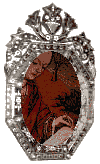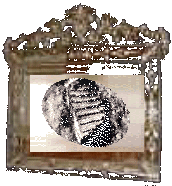|
Column for Rubric Material
**More about Marguerite Porete **Threaded voices **General Navigation |
Marguerite of Hainaut, Introduction to The Mirror of Simple Annihilated Souls: "When she saw this far-off love - though so close within her heart - was so far outside her, she thought she would seek comfort in her sorrow by somehow imagining the appearance of her beloved who so often brought suffering to her heart. Thus she had a portrait painted to the likeness of the king she loved, as close as possible to the way she pictured her beloved to be, according to the sentiment of love that pervaded her. And by means of this image, together with her other practices, she dreamed the king himself." (Brunn and Epiney-Burgard 165) Marguerite's solution, in the absence of the real thing, was to dream the ideal. In an important sense, traveling within the constraints of the real world yet dreaming an impossible vision is the path of the artist as well as the mystic. And there is always an aspect of annihilation. The term, annihilation, as used by Marguerite, is not so much the destruction of the will as it is a letting go. One does the work, materializes the ideal, and then releases it to an unknown fate. In 1990, Mark Bernstein (Bernstein, 1990), author and Chief Scientist at Eastgate, stood before the European Conference on Hypertext and uttered the famous first words, "Where are the hypertexts?" We have heard the echoes of that question, now, for over ten years. "Hypertext" in its purest form is still not represented by what appears to be a large body of work. Partially, the apparent insignificance of hypertext literature may stem from the inclusiveness of digital work. Hypermedia literature is sometimes categorized as "Web art," or as "sound experiment," or even as "narrative game." When literary pieces appear under the auspices of primarily "art" venues, they often escape the notice of their traditional audiences (and vice versa). Then, too, hypermedia literature, in academic institutions, can be found in schools of design, computer graphics, communication, or new media as often as in literature itself. If we throw the widest net over all digital arts, we have a remarkable selection and variety of "hypertexts." The field is thriving, new work appears daily, a small but fascinating body of critical commentary has emerged, and entities such as Digital Arts and Culture and The Electronic Literature Organization (based at UCLA) have instituted conferences and awards to legitimatize this work. Finally, the chaotic aspects of the technology have, in some way, become embedded in the qualities of hypermedia literature: it is innovative and fluid, always reaching for a new fusion of the real and the imagined. The complexities of permanence, impermanence, alteration, obsolescence, and obliteration will not disappear from the creative environment of the hypermedia writer. And, while it is advisable for a writer in a rapidly changing field to cultivate the acceptance of annihilation, every new field needs its practitioners to do good, steady work over a period of time, regardless of the difficulties. Assessing hypermedia literature in the light of the technology that shapes it is, I think, the challenge for hypertext/hypermedia readers, critics, and publishers. And the writers, artists, musicians, programmers, and designers who make hypermedia literature must continue to see as through a glass, brightly.
[For a partial survey of the writers and artists working in Web-specific hypermedia, see The Progressive Dinner Party (Carolyn Guertin and Marjorie Coverley Luesebrink) and Jumpin' at the Diner (Marjorie Coverley Luesebrink with Jennifer Ley) - both published in 2000 at Riding the Meridan. Note: Some of these pieces may not be accessible by W3C standards.] Recto / Permanence / Impermanence / Alteration / Obsolescence / Obliteration / Verso
|
 Verso
Verso